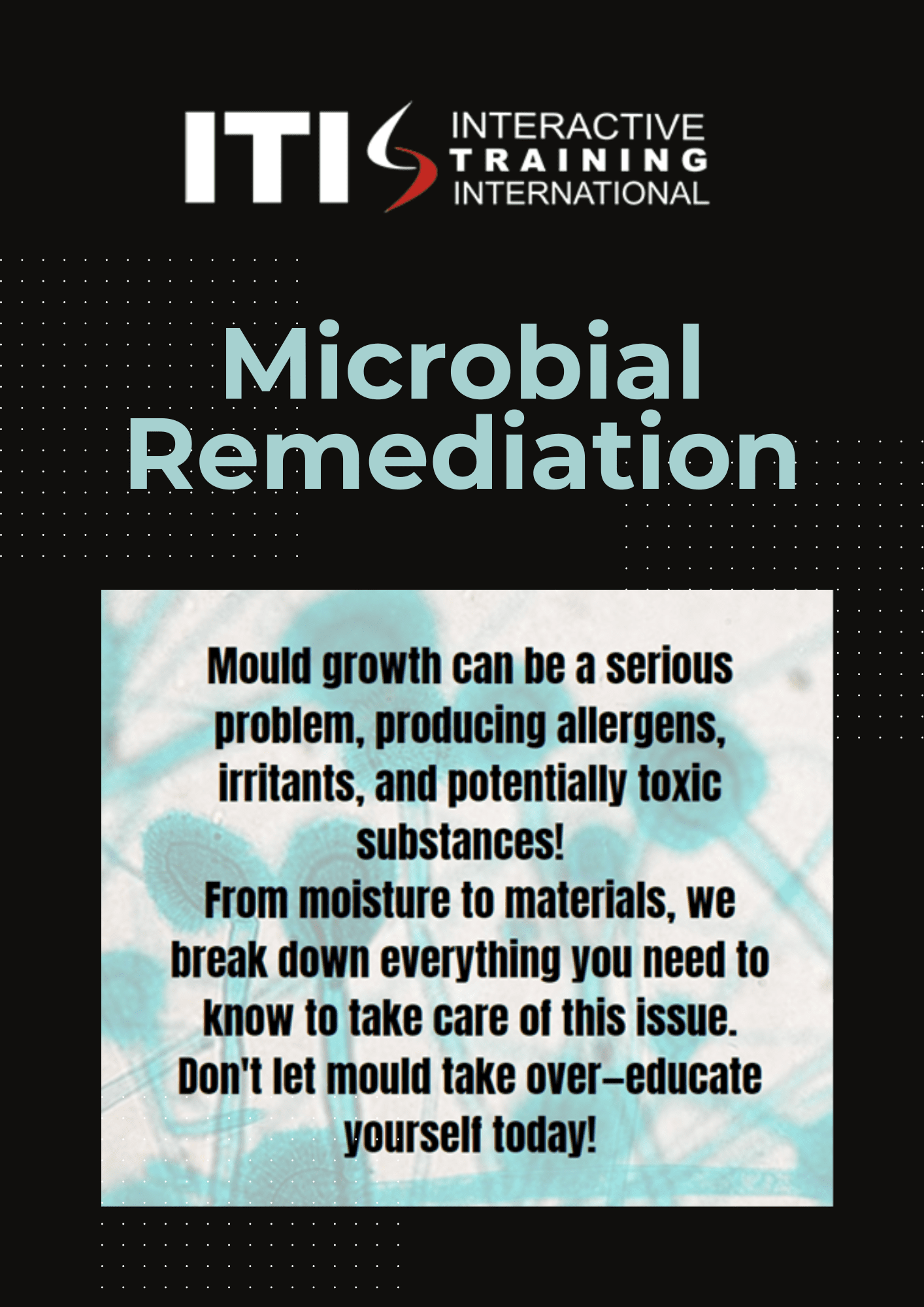Mould remediation involves identifying hidden moisture, containing spores, removing affected materials, and preventing recurrence. Using HEPA filtration, dehumidifiers, and microbial chemicals ensures safe, long-term mould control in homes and commercial properties.
Mould isn’t just unsightly, it’s a biological hazard that threatens indoor air quality, damages structural materials, and poses health risks to occupants. In both commercial and residential buildings, it often hides behind walls, under flooring, or within HVAC systems, making surface cleaning alone ineffective.
That’s why proper mould remediation requires more than bleach and elbow grease. It demands advanced moisture detection, certified removal protocols, and HEPA-grade air control. Whether you’re a restoration technician, facilities manager, or property owner, understanding the full lifecycle of mould, from colonisation to recurrence, is critical to protecting your assets and the people within them.
In this guide, we break down the science and strategy of professional mould remediation. You’ll learn how to identify early signs, measure critical moisture levels, execute safe removal, and implement lasting prevention methods using industry-leading tools like dehumidifiers, air scrubbers, and microbial solutions. We also cover hands-on certification training for restoration professionals seeking to improve safety, compliance, and long-term remediation outcomes.
What Is Mould and Why Is It Dangerous?
Mould is a type of fungus that reproduces through microscopic spores. These spores are always present in the environment, but when they encounter moisture and organic material, they begin to colonise and spread. Common species such as Aspergillus, Penicillium, and Stachybotrys chartarum (often referred to as “black mould”) thrive in damp indoor areas like bathrooms, subfloors, ceilings, and HVAC systems.
Mould exposure can lead to a wide range of health concerns, particularly for individuals with asthma, compromised immune systems, or sensitivities to airborne allergens. In commercial settings, mould can also increase liability risks and trigger workplace health and safety violations.
Visible mould growth is only part of the problem. In many cases, mould colonisation occurs behind walls, under carpets, or inside air ducts, areas that require professional moisture detection tools such as thermal hygrometers and digital moisture meters to diagnose effectively.
When Does Mould Become a Problem? (Moisture Levels & Growth Timelines)
Moisture content plays a critical role in the spread of mould. Spores begin germinating on organic surfaces once the moisture content (MC) reaches approximately 16%, and growth accelerates beyond 20–30%, depending on the material.
To provide context:
- 16% MC – Lower limit for mould colonisation
- 20% MC – Growth accelerates; toxic species like Stachybotrys begin spreading
- 30% MC – The Risk of wet rot and microbial decay significantly increases
This is why moisture monitoring is a foundational aspect of any mould remediation process. Within 48 to 72 hours, certain species can develop extensive colonies under favourable conditions. When left untreated, these colonies degrade air quality, release toxins, and cause structural weakening of timber and plasterboard.
We stock professional-grade dehumidifiers and air movers that allow restoration professionals to quickly reduce moisture levels and prevent further microbial activity.
Signs You Need Professional Mould Remediation
Mould doesn’t always announce itself through obvious black patches on the wall. Often, the first signs are subtle:
- Persistent musty or earthy odours
- Respiratory symptoms in building occupants
- Discolouration or bubbling paint on ceilings and walls
- Visible condensation on windows or interior surfaces
- Recent leaks or flood damage
In situations where mould recurs after surface cleaning or when it’s found near structural elements such as HVAC systems or timber framing, professional remediation is not optional; it’s essential.
We support industry professionals with tailored microbial remediation solutions, including HEPA filtration equipment and microbial cleaning agents, which help eliminate mould safely and effectively.
Our Mould Remediation Process
Our remediation approach is grounded in industry standards, science-based protocols, and equipment that delivers consistent results across jobs of all sizes. Below is a step-by-step breakdown of how we support effective mould removal:
1. Inspection and Moisture Mapping
We begin by identifying areas with elevated moisture using tools like infrared moisture meters and thermal imaging. This helps locate hidden mould colonies and determine the underlying cause.
2. Containment
To prevent cross-contamination, containment barriers and negative air pressure setups are implemented using air scrubbers with HEPA filters. This is critical in commercial environments or shared ventilation systems.
3. Source Elimination
We address the root of the problem, whether it’s leaking pipes, unsealed bathrooms, or poor subfloor ventilation. Correcting these moisture sources is what prevents mould from returning.
4. Removal and Cleaning
Depending on the material, this may involve damp wiping, abrasive removal, or targeted application of mould remediation chemicals. Non-salvageable materials are disposed of safely to prevent reinfestation.
5. Air Filtration and Post-Testing
Using commercial HEPA filtration units, we scrub airborne spores before post-remediation sampling is carried out to ensure clearance.
Advanced Equipment for Effective Mould Remediation
High-quality tools are non-negotiable when it comes to professional mould remediation. We not only supply but also support restoration professionals with premium-grade machinery that ensures safety, speed, and compliance.
Here are the key equipment categories that elevate the results of mould remediation projects:
Dehumidifiers
Removing excess moisture quickly is the cornerstone of mould prevention. Our range of dehumidifiers is designed for both small and large-scale water-damaged environments. LGR (Low Grain Refrigerant) units, such as the Dri-Eaz LGR 7000XL,i offer rapid moisture extraction from walls, flooring, and air.
Air Movers
Air movers accelerate the drying process by directing airflow across wet surfaces. Our air movers are trusted by professionals for their high CFM output and portability, helping reduce drying time and limit mould development.
HEPA Filtration Units
Spore control is critical during any remediation process. Our HEPA filtration systems capture airborne contaminants with 99.97% efficiency, making them essential for maintaining indoor air quality and meeting IICRC S520 standards.
Microbial Cleaning Solutions
Our exclusive line of microbial remediation chemicals is formulated to neutralise mould and mildew at the source. These solutions are compatible with a wide range of surfaces, from timber to textiles.
By equipping professionals with industry-leading tools and knowledge, we ensure remediation outcomes that are not only effective but also long-lasting.
Training and Certification: Empowering Restoration Experts
Mould remediation is both a science and a skill. Recognising the importance of education in achieving safe, compliant outcomes, we offer a comprehensive microbial remediation course designed for technicians, restorers, and property professionals.
What’s Included in Our Training Program:
- Moisture detection and environmental assessment techniques
- Containment methods, including barrier setup and air management
- Safe removal protocols for porous and non-porous materials
- Chemical application training using professional-grade solutions
- Final clearance testing and post-remediation verification
- Access to the ITI Certification upon completion
- 12-month membership and ongoing support
Participants gain practical skills using real-world equipment like our CRB brushes, thermal meters, and safety gear, ensuring they’re job-ready from day one.
Prevention: Long-Term Solutions Beyond Removal
Eliminating visible mould is only the beginning. The true goal is to prevent it from returning. That’s why we emphasise not only cleaning but also long-term remediation strategies focused on moisture control and environmental design.
Proactive Measures Include:
- Installing dehumidifiers in high-moisture areas (bathrooms, basements)
- Sealing grout and porous surfaces using professional sealers
- Enhancing ventilation with proper ducting and exhaust systems
- Scheduling regular inspections using digital meters
- Using odour control equipment to detect hidden colonies by scent detection
We also recommend including moisture management best practices in all post-flood restoration jobs to prevent microbial bloom during drying phases. Tools like truckmounts and CRB machines can assist with deeper cleaning that eliminates biofilm before it becomes a breeding ground.
Why Professional Mould Remediation Matters
Mould is not simply a surface-level problem; it’s a structural and health hazard that requires expert handling. While minor issues may appear manageable, the real risk lies beneath the surface: within walls, under flooring, and inside HVAC systems. Delays or ineffective treatment can lead to recurring growth, worsening air quality, and increased restoration costs.
By choosing to work with professionals equipped with advanced tools, certified knowledge, and safe chemical solutions, you safeguard both the property and the people in it.
We do more than supply products; we support your success from start to finish. Whether you’re sourcing reliable HEPA filtration units, enrolling in our certified remediation training, or expanding your kit with essential microbial chemicals, we’re here to ensure your service is backed by industry expertise and trusted solutions.
Ready to Take the Next Step?
Whether you’re a seasoned professional looking to upgrade your remediation equipment or you’re entering the field and need foundational training, we’re here to help you succeed. Our full range of equipment, chemicals, and accessories has been curated to meet the exacting demands of real-world restoration projects.
Explore our specialised microbial remediation category, or speak with our expert team about how we can support your next project.
Partner with Us for Safer, Smarter Mould Remediation
Our mission is to elevate the cleaning and restoration industry through dependable products, professional training, and tailored support. Mould remediation isn’t a one-size-fits-all service; it demands precision, compliance, and expert judgment at every stage.
Whether you’re restoring a flooded commercial facility or remediating domestic water damage, we supply everything you need:
- Specialised mould treatment chemicals – including microbial remediation, odour and urine control, and fire damage restoration
- Industry-proven equipment – from dehumidifiers and air movers to complete water damage systems
- Ongoing training and certification – through our in-depth Microbial Remediation Course
By equipping yourself with reliable tools and industry-backed knowledge, you not only meet compliance standards, you exceed client expectations.
Prevention is Profitability
Mould isn’t always visible, but its effects are long-lasting. Successful remediation is about prevention as much as removal. That’s why we support professionals across the industry with everything from initial moisture detection to final post-treatment air filtration.
Explore our range of professional-grade mould remediation solutions today and take the next step toward safer, healthier outcomes, every time.



